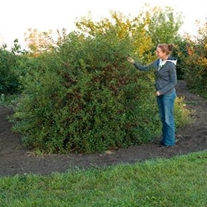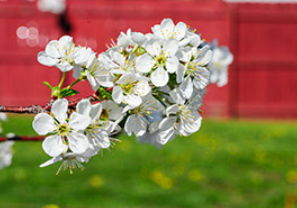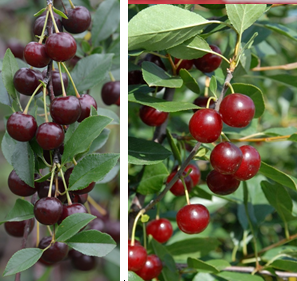Dwarf cherries—like Juliet, Romeo and Carmine Jewel—are real breakthroughs in cherry trees. They represent over 50 years of breeding work, begun in the 1940’s by Dr. Les Kerr.
Dwarf cherries manage to combine the best of all cherry worlds. These outstanding trees have the compact plant size and excellent hardiness of Mongolian cherries (Prunus fruticosa—a medium-sized suckering shrub with edible, cherry-like fruit), the heavy fruiting capabilities of sour cherries and the sugar levels and texture of a sweet cherry.
Bred in Zone 2B (Saskatoon, Saskatchewan), dwarf cherries will survive winter lows of -40 F without damage and begin bearing within 3 years of planting. Harvests of 20-30 pounds of fruit are typical by the time a dwarf cherry reaches 5 years old.
Because of their compact size, it’s so much easier to grow, care for and harvest cherries from dwarf cherry trees than traditional cherry trees. Dwarf cherry trees usually mature at 6 feet tall, although it can range from 5-8 feet. This means the cherries are easily within reach when harvesting. While Juliet is not bothered by too many pests or diseases, birds do love her fruits. We highly recommend netting the bushes after fruit turns red.
While their smaller size makes them easy to incorporate into any landscape, dwarf cherries also work beautifully in a container. Ornamental showy white blooms appear in the spring and glossy green foliage provides the perfect backdrop for jewel-like red fruit in the summer.
We currently offer 3 varieties of exceptional dwarf cherries: Juliet, Romeo and Carmine Jewel. Carmine Jewel is a great variety for drying; Romeo is tops for juice, wine and jellies; Juliet truly is the tastiest of the dwarf cherry bunch. While she’s a superb cherry for fresh eating, don’t expect the exact same experience as popping a Bing cherry into your mouth. While Juliet’s sugar levels are actually higher than a sweet cherry like Stella or Bing, Juliet also has a much higher acid level. With Juliet, you get a more complex, sweet-tart, taste sensation!
One thing to keep in mind with Juliet cherry is that there is quite a variance in fruit color as the cherries ripen. Though the cherries on the right are simply gorgeous to gaze upon, the fruits on the left are actually at their peak ripeness and flavor levels.
While Juliet cherries are fantastic for fresh eating, don’t stop just there. I’ve found that they freeze beautifully, retaining their texture, color and flavor. Half-thawed Juliet cherries spread over the top of premium vanilla ice cream and sprinkled with dark chocolate shavings is an indulgence you must try.
Juliet cherries also make an excellent ice cream or gelato. Their rich sweet-tart flavor complements the creamy sweetness of the ice cream base, while their rich red color creates the most beautifully pink-tinted ice cream.
For a slightly healthier treat, try Juliet cherries in a low-fat sorbet or blended into your favorite smoothie recipe. They also work wonders in traditional baked goods such as pies, crisps and clafaoutis (a traditional French desert made with fruit covered with a thick flan-like batter. It’s very easy and very delicious).







